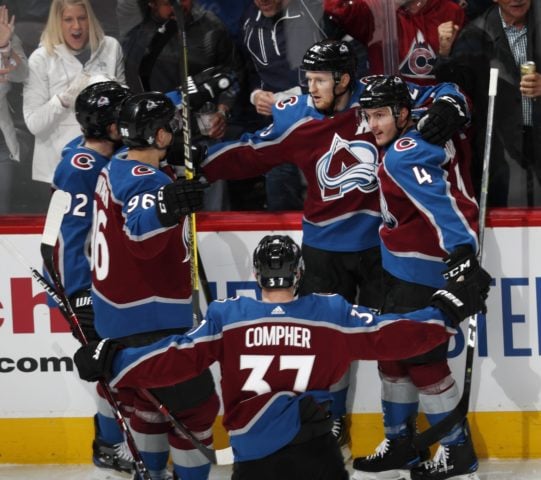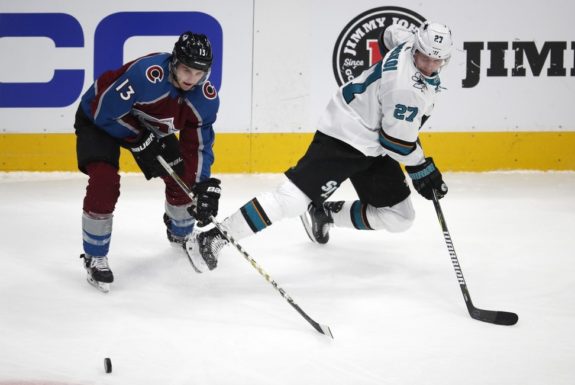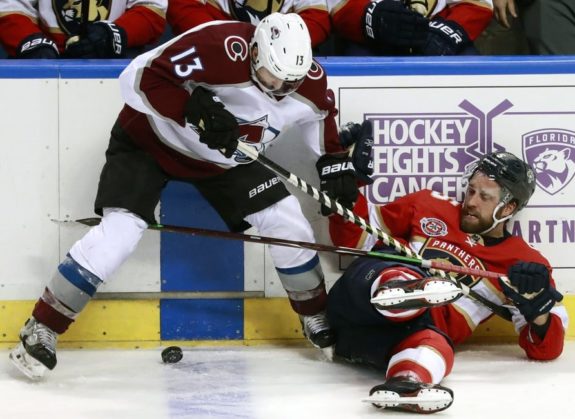Lost in all the Mikko Rantanen contract talk is fellow restricted free agent Alexander Kerfoot, who has quietly proven to be an important player for the Colorado Avalanche. He’s improved his game throughout both seasons with the club and could be in line to get an increased workload for 2019-20. Kerfoot posted his second straight season of 40-plus points after finishing at Harvard in 2016-17.
He isn’t known as an offensive chances driver but he still managed to increase those numbers to a positive this season at 5-v-5. His actual point totals are heavily influenced by power-play points, recording 16 of his 42 total points on the man advantage. Of those 16 points, 12 were assists and 10 of those were secondary assists. There’s nothing wrong with that when the general play is all – or mostly – positive.
How Kerfoot Looks at 5-v-5
Even though his general play got better from season to season, Kerfoot’s point totals actually went down. His points-per-60 minutes (P60) at 5-v-5 went from 1.89 in 2017-18 to 1.39 in 2018-2019. Which season is truer at this point in his career?
The above 24% shooting percentage during his rookie season left him with five more goals than his second season. That was certainly not going to be sustainable. He was down four points at 5-v-5 from the first season to the second. If we go quickly at offense, the safe play is he’s closer to the 1.39 P60.

The drop in shooting percentage accounts for the missing points but it also doesn’t tell the full story. Kerfoot was with J.T. Compher and Colin Wilson for around thirty percent of his 5-v-5 time. That combination allowed the Avalanche to get more out of Compher and Wilson but potentially less out of Kerfoot.
If we are looking at value on their next contracts, I would wager that Kerfoot ends up bringing more to his than Compher will. Even if you have to go beyond face value.
When Kerfoot is on the ice without Compher, the Avalanche enjoyed 52.36% of the shot attempts going in their favor. Together it was 47.49%, and when Compher is one the ice without Kerfoot it drops to 45.98%. Wilson is not much better. On the same stat-line with him, we have 51.53% with Kerfoot away, 49.74% together and a 46.19% rating when Wilson is on the ice without Kerfoot.
That trend continues for the limited minutes that Kerfoot shared the ice with Carl Soderberg and Gabriel Bourque. The picture should be getting clearer. The only players that Kerfoot didn’t carry were Nathan MacKinnon, Gabriel Landeskog and Rantanen. I think that’s acceptable.
For a team that could have used a possession boost throughout the season, it makes no sense to willingly trap a quality player like Kerfoot. This deployment failure is also cause to justify a lower offensive output. With better driving-quality linemates – something the Avalanche are capable of doing – it’s reasonable to assume Kerfoot can get his even strength numbers to increase rather easily.

Defensively, the Avalanche saw the biggest drop in shot attempts against when Kerfoot is on the ice. His minus-3.76 Corsi against per-60 was 44th best for players with a 900-minute minimum at 5-v-5. This is a forward who is defensively aware and makes smart decisions protecting the puck with a high success rate of 1.26 giveaways-per-60.
Kerfoot has the sixth-fewest offensive zone faceoffs per sixty minutes on the team so he isn’t being heavily sheltered. He is earning his good possession numbers by carrying lesser players with similar zone starts across the ice. He is utilized both at center and on the wing.
What Could the Cap Hit Look Like?
All things considered, Kerfoot is a valuable player for the Avalanche. The EvolvingWild projection model puts the Avalanche forward at a two-to-four year deal worth $2,876,024 per season. A recent article from The Hockey News had him at around $2.5M.
This should be pretty close to expectations for most, perhaps even lower for some. With his current numbers and a potential higher offensive ceiling, a two-year deal at $3 million per season might be a realistic outcome for both player and team.

It’s a good deal for the Avalanche who should be planning on being an annual playoff team. Colorado is a team that likes to keep costs low, but with Rantanen’s contract coming they need to be cost efficient. Kerfoot is seemingly a perfect fit for cost efficiency. The Avalanche are by no means in any sort of cap crunch, but in today’s NHL you need to spend wisely all of the time.
Kerfoot as an Offer Sheet Target
He could very well be the target of an offer sheet if teams believe Colorado won’t match an offer near the high limit of the $2,113,717 – $4,227,437 range. The compensation that would be required is a second-round pick in 2020. That is not a fair trade from the Avalanche perspective, so it’s highly likely they would match.
It’s also likely a team isn’t willing to commit $4.2 million to Kerfoot for more than two seasons, which makes matching an even easier decision for Colorado. Even at what might be perceived as a slightly absurd price, he is still valuable for those two seasons. This is all ignoring the reality that offer sheets are highly unlikely to happen.
The biggest takeaway from all of this should be that Kerfoot is an effective player the entire length of the ice. He also happens to be proficient at the center ice position. Teams simply don’t win without depth down the middle. Colorado got away from lining Kerfoot up at center during the playoffs and that’s something they may want to go back on given how stable he is.

Rantanen is (and should be) the priority, but Kerfoot is also an important part of the on-ice success in Colorado. If the anticipated dollar range is accurate, then the Avalanche are going to be very happy with what they get for however long the contract duration ends up being
*all stats from naturalstattrick.com